Breast or bottle - 5 tips to calmer feeding
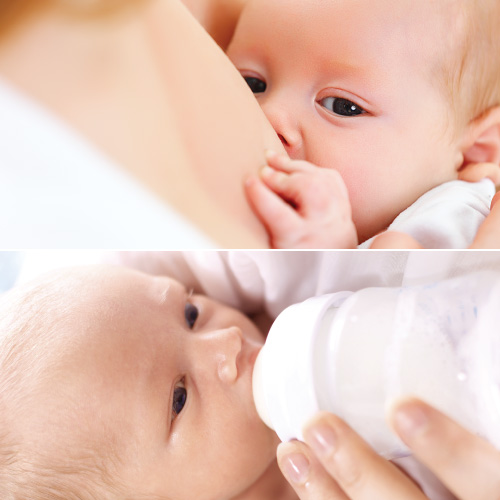
Although I give out this advice to all the mother’s I spend time with, this particular article was inspired by a mother and her 6 month old daughter whom I have been remotely helping over the past week in Turkey. So thank you Eda and Luna.
Eda found that when she went to latch Luna on for a feed, she would bop on and off her nipple and not feed for long, or feed sporadically. Luna would also pedal her legs, exhibit the startle reflex and arch backwards. This breastfeeding scenario happens A LOT and it can at times make feeding stressful, as Eda expressed to me, sometimes creating sore nipples and raising that question that all breastfeeding mothers ask ‘how do I know she is getting enough, especially when she feeds like that.’
When a baby is bottle fed they can also react the same way – pedalling their legs, startling and squirming as they drink. But in this case they are less likely to be able to pull away from the teat. Instead, they might suck harder as they react to the movement and/or discomfort. This gives parents the impression they are extremely hungry, while their baby takes in more air from gulping the milk.
Why does a baby make these movements?
All of these cues tell you that your baby is feeling some movement and/or discomfort in their digestive system, whether it is in the stomach, intestine or bowel. Digestive discomfort is very common in newborns. In fact I don’t think any newborn actually avoids it even if you are feeding and burping your baby alongside their digestive capabilities and capacities - I call this Bio-logical Feeding.
These cues are instinctual to babies and it makes logical sense that they would be. One, because they are learning what all of those new feelings are like for the first time as their digestive system adapts to its new food and levels of wind. Two, we are all human and we adults actually react the same way. Ask yourself, what do you do when you have a sore stomach? Or a sudden pain in the intestines? You cringe toward that area. You tense up and all focus goes toward that pain. Our babies are the same. Suddenly feeding isn’t their main focus and they communicate this to us by bopping on and off the breast, pedaling legs, gulping at the bottle and arching backwards.
Another aspect to remember is that newborns, unlike adults, do not have the ability to retain food in the stomach if it is full. This means that what goes in, may also be pushing undigested and digested milk onward to the duodenum along with moving everything in their intestines and in the bowel. That can create a lot of gurgling and rumbling as they feed, along with discomfort.
Over the years, my clinical research has also shown that the most sensitive part of the digestive system for waste and trapped wind to pass through for a baby is the lower regions, from the lower intestine into the bowel. This lies across the entire lower torso, almost from one hip to the other. Discomfort here often has newborns instinctively crying out for our help as this movement happens, especially if they have Digestive Overload.
What you can do to foster calmer feeds and attend to these cues?
Tip one
One of the things that many parents do, and I used to do before I found this trick, is walk around with baby in a vertical position just before the feed. You then sit down, sort out any paraphernalia - cushion, bra, bottle, bib with baby in that vertical position, perhaps over your shoulder - and then lay baby down and latch them on to either the nipple or teat, right? It’s normal. Something we don’t even consider, but this simple lead into a feed is one of the reasons feeding can be sporadic.
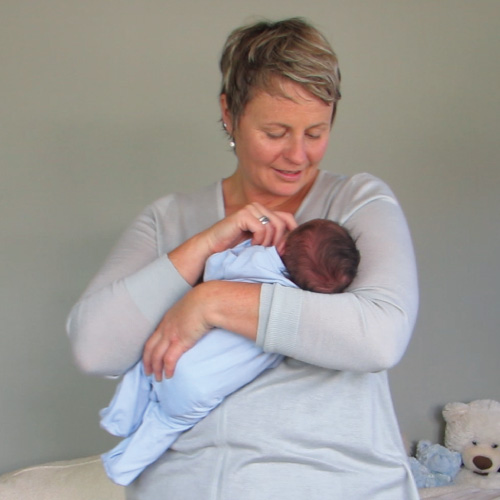
Placing your feet in your baby’s shoes, when they are in the vertical position for all of that time, their remaining food in the stomach, waste and gas in their entire system has found a somewhat comfortable place to settle, so to speak. When we then change them into the lying the position all of this has to move again and all while you are trying to latch baby on for a feed. Not only is there then a lot of things going on at the same time for them to mentally process, the physical movement will often have them not latching well.
So, what can you do about this? About five minutes before a feed lay your baby into their feeding position and with a nice firm hold, newborns love secure firm holds, stimulate a pacifier correctly into their mouth and let them suck this until they are relaxed. At times you may have to walk around and sway them a little to enable calm, depending how much digestive movement and/or discomfort they are feeling. By doing this, you allow time for their food, waste and gas to settle and move before trying to latch them on. This technique can make a big difference to how a baby feeds on the breast and bottle. It is also what I recommend doing when you are settling baby to sleep.
Tip Two
Lay baby flat when feeding, even if they have reflux (Gastroesophaguel Reflux – GER). It is largely taught that feeding a baby up-right benefits reflux but after years of trying both ways, I’m more on the thinking that it actually causes more issues.
As mentioned above, what goes in the stomach pushes everything else onward in the digestive tract. When a baby sits up-right to feed this restricts the natural progression of their waste and gas as their torso area, particularly the lower region where they feel heightened discomfort, is bent.
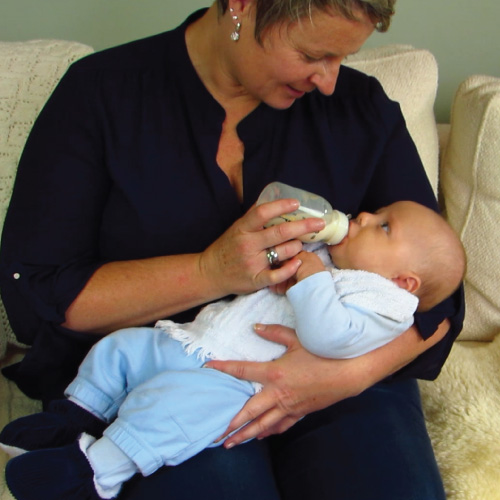
By laying your baby flat to feed you allow room for their digestive system to work well. If on sitting your baby up after the feed they reflux, this is normal to a certain degree. More about reflux can be read here.
Tip Three
With your flat hand, place pressure on your baby’s lower digestive area, or on the area that they are showing you is uncomfortable while they feed. For example, their left leg keeps coming up as a cue to their discomfort in that area so you would offer them an innate aspect of being a human that they cannot do yet, and place firm pressure there, and it is firm pressure. Ask yourself, what is one of the things you do when you feel big digestive pain? You bend over and place pressure on that area. It is instinctual for us, just as it is for your baby, to want pressure but they obviously can’t do that yet so we need to do this for them. When we do this during a feed, latch and sucking can calm considerably.
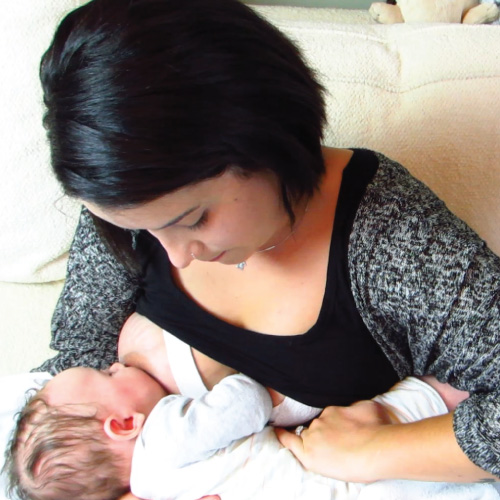
Tip Four
This tip is more for breast feeders than bottle. According to renowned zoologist and ethnologist Desmond Morris, “Laying baby on their right hand side after a feed is far better than their left because of the design of the baby’s stomach. This simple measure reduces wind problems, allowing the trapped air to escape more easily.” This also alleviates discomfort. When you next have digestive discomfort from food or wast try lying on your left hand side for five minutes, followed by the back and then the right hand side. On the right hand side the stomach feels so much better. In regards to breastfeeding, it can therefore be helpful to have baby laying on their right hand side for every feed. This means you would use the cross cradle position for the left breast and a rugby hold for your right breast feed. Again, this can make a considerable difference to latching and consistent sucking for newborns.
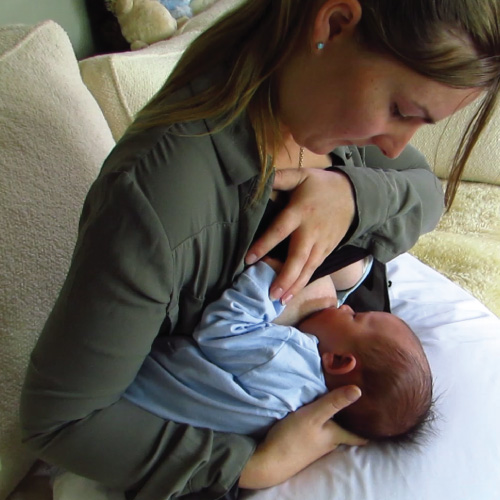
Tip Five
This is one for the bottle feeders. When a baby is feeling discomfort while drinking on the bottle they can gulp while sucking, or suck harder which has them swallowing more air, causing more digestive discomfort. To limit this occurrence observe your baby’s suck and breathing during the feed and when their breath quickens and they swallow faster - trying to catch their breath and synchronise swallowing — allow them time to catch their breath by breaking the seal on the teat, pulling it out slightly to stop the milk from flowing and angle it so the teat rests on their bottom lip, thus stopping their suck. This will help retain calm while they reinstate relaxed breathing and you can then slip the teat back into the mouth. More can be read about feeding a bottle here.

I hope with all my heart these tips of mine foster an understanding between you that is not only baby-cue lead but also restores responsive, calm feeding. I'm always happy to hear how my techniques went for you.


